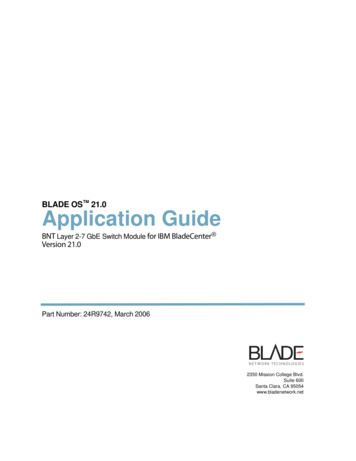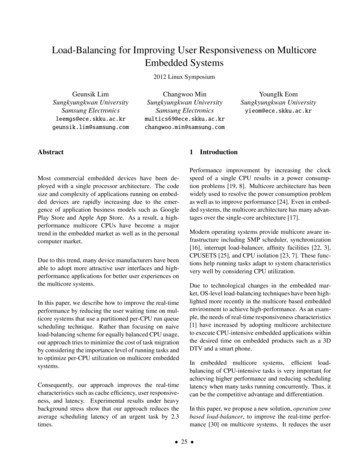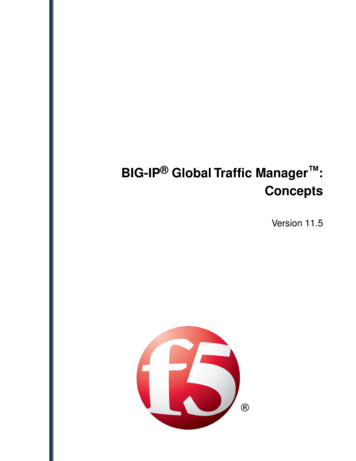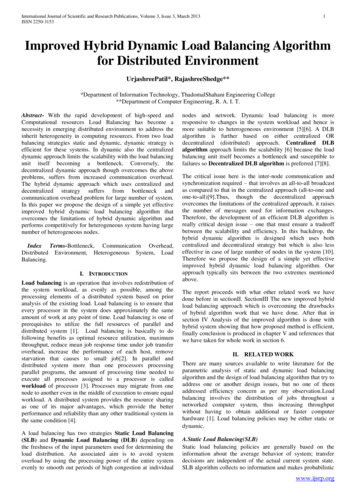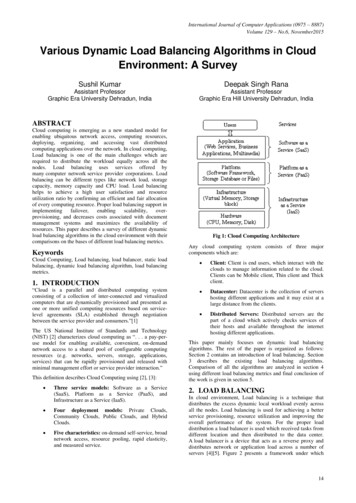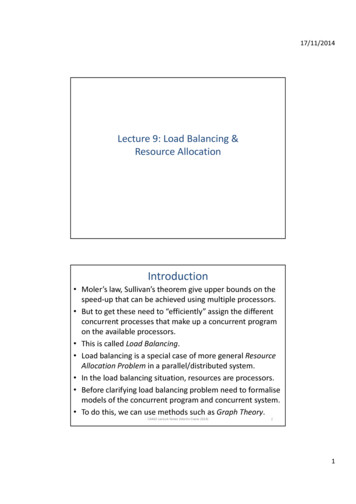
Transcription
17/11/2014Lecture 9: Load Balancing &Resource AllocationIntroduction Moler’s law, Sullivan’s theorem give upper bounds on thespeed-up that can be achieved using multiple processors. But to get these need to “efficiently” assign the differentconcurrent processes that make up a concurrent programon the available processors. This is called Load Balancing. Load balancing is a special case of more general ResourceAllocation Problem in a parallel/distributed system. In the load balancing situation, resources are processors. Before clarifying load balancing problem need to formalisemodels of the concurrent program and concurrent system. To do this, we can use methods such as Graph Theory.CA463 Lecture Notes (Martin Crane 2014)21
17/11/2014Sources of Parallel Imbalance Individual processor performance– Typically in the memory system Too much parallelism overhead– Thread creation, synchronization, communication Load imbalance– Different amounts of work across processors (comp: comms ratio)– Processor heterogeneity (maybe caused by load distribution) Recognizing load imbalance– Time spent at synchronization is high/uneven across processorsCA463 Lecture Notes (Martin Crane 2014)3Aside: Graph Theory Directed graph are useful in the context of load balancing Nodes can represent tasks and the links representing data orcommunication dependencies Need to partition graph so that to minimize execution time. The graph partition problem is formally defined on datarepresented in the form of a graph ( , ) with vertices and edges It is possible to partition into smaller components withspecific properties. For instance, a -way partition divides the vertex set into smaller components. A good partition is defined as one in which the number of edgesrunning between separatedcomponents is small.CA463 Lecture Notes (Martin Crane 2014)42
17/11/2014Graph Theory (cont’d) Partition such that– with / – As few of connecting with as possible If ܸ {tasks}, each unit cost, edge , (comms betweentask and task ), and partitioning means– with / i.e. load balancing– Minimize i.e. minimize comms As optimal graph partitioning is NP complete, so use heuristics Trades off between partitioner speed & with quality of partition Better load balance costs more and law of diminishing returns?CA463 Lecture Notes (Martin Crane 2014)5Formal Models in Load Balancing: Task Graphs A task graph is a directed acyclic graph where– nodes denote the concurrent processes in a concurrent program– edges between nodes represent process comms/synchronisation– nodal weight is the computational load of the process the noderepresents– edge weight between two nodes is the amount of commsbetween two processes represented by the two nodes.15112210483523255CA463 Lecture Notes (Martin Crane 2014)63
17/11/2014Formal Models in Load Balancing:Processor Graphs The processor graph defines the configuration of theparallel or distributed system. Each node represents a processor & the nodal weight is thecomputation speed of this processor. The edges between nodes represent the communicationlinks between the processors represented by the nodes. Edge weight is the speed of this communications link.241111154416431141CA463 Lecture Notes (Martin Crane 2014)7Load Balancing Based on GraphPartitioning: Typical Example The Nodes represent tasksThe Edges represent communication costThe Node values represent processing costA second node value could represent reassignment costCA463 Lecture Notes (Martin Crane 2014)84
17/11/2014Load Balancing: The Problem To partition a set of interacting tasks among a set ofinterconnected processors to maximise “performance”. Basically the idea in load balancing is to balance the processorload so they all can proceed at the same rate. However formally can define maximising “performance” as:– minimising the makespan1, :min( ) min( max ) – minimising the response time, the total idle time, or– any other reasonable goal. A general assumption that is made is that the comms betweentasks on the same processor is much faster than that betweentwo tasks on different processors. So intra-processor comms is deemed to be instantaneous.1 whereCA463 Lecture Notes (Martin Crane 2014)makespan is defined as the maximum completion time of any of the tasks9Load Balancing: Allocation & Scheduling Load Balancing has two aspects:– the allocation of the tasks to processors, and– the scheduling of the tasks allocated to a processor. Allocation is usually seen as the more important issue.– As a result some load balancing algorithms only address allocation. Complexity of the problem:––––Find an allocation of ݊ arbitrarily intercommunicating tasks,constrained by precedence relationships,to an arbitrarily interconnected network of m processing nodes,meeting a given deadlinethis is an NP complete problem. Finding min( ܥ ௫ ) for a set of tasks, where any task can execute onany node and is allowed to pre-empt another task, is NP completeeven when the number of processing nodes is limited to two.CA463 Lecture Notes (Martin Crane 2014)105
17/11/2014Casavant & Kuhl’s Taxonomy A hierarchical taxonomy of algorithms is by Casavant and Kuhl.localglobaldynamicstaticoptimalphysically physicallydistributed non-distributedsub-optimalapproximateheuristic imate heuristicenumerative graph theory math. prgm. queuingtheoryCA463 Lecture Notes (Martin Crane 2014)11Casavant & Kuhl (cont’d):Static V Dynamic Static Algorithms:– nodal assignment (oncemade to processors) isfixed– use only info about theaverage behaviour of thesystem.– ignore current state/loadof the nodes in thesystem.– are obviously muchsimpler. Dynamic Algorithms:– use runtime state info tomake decisions– i.e. can tasks be movedfrom one processor assystem state changes?– collect state informationand react to system stateif it changed– are able to givesignificantly betterperformanceCA463 Lecture Notes (Martin Crane 2014)126
17/11/2014Casavant & Kuhl (cont’d):Centralized V Distributed Centralized Algorithms:– collect info to servernode and it makesassignment decision– can make efficientdecisions, have lowerfault-tolerance– must take account ofinfo collection/allocationtimes Distributed Algorithms:– contains entities to makedecisions on apredefined set of nodes– avoid the bottleneck ofcollecting state info andcan react faster– don’t have to takeaccount of info timesCA463 Lecture Notes (Martin Crane 2014)13Load Balancing: Coffman’s Algorithm This is an optimal static algorithm that works on arbitrary task(program) graphs. Since generally, the problem is NP-complete, some simplifyingassumptions must be made:1. All tasks have the same execution time.2. Comms negligible versus computation. Precedence ordering remains. The Algorithm1. Assign labels 1, , to the terminal (i.e. end) tasks.a)b)c)Let labels 1, , 1 be assigned, and let be the set of tasks with nounlabelled successors.For each node in define ( ) as the decreasing sequence of the labels of theimmediate successors of .Label as if ( ) ( ᇱ )(lexicographically) for all ’ in .2. Assign the highest labelled ready task to the next available time slotamong the two processors.CA463 Lecture Notes (Martin Crane 2014)147
17/11/2014Coffman’s Algorithm: Example15161Nodes Inv Lex6 87 10 8These Nodes have no 13Unlabelled Successors1114815Gantt Chart3P1314P221157912131710681416154Nodes7121096 12117568289101110 94 132163 1714117Inv Lex641654655These Nodes have noUnlabelled SuccessorsThese Nodes have noUnlabelled Successors5NodesCA463 Lecture Notes (Martin Crane 2014)Inv Lex Order of Successors14 3113 312 3215Scheduling Algorithms Concepts of load balancing & scheduling are closely related. The goal of scheduling is to maximize system performance,by switching tasks from busy to less busy/ idle processors A scheduling strategy involves two important decisions:1. determine tasks that can be executed in parallel, and2. determine where to execute the parallel tasks. A decision is normally taken either based on priorknowledge, or on information gathered during execution.CA463 Lecture Notes (Martin Crane 2014)168
17/11/2014Scheduling Algorithms: Difficulties A scheduling strategy design depends on the tasks’ properties:a) Cost of tasks– do all tasks have the same computation cost?– if not, when are costs known? before execution, on creation, or on termination?b) Dependencies between tasks– can we execute the tasks in any order?– if not, when are task dependencies known?– again, before execution, when the task is created, or only when it terminates?c) Locality– is it important that some tasks execute in the same processor to reducecommunication costs?– when do we know the communication requirements? Have come up against a lot of these ideas already in MPI LecturesCA463 Lecture Notes (Martin Crane 2014)17Scheduling Algorithms: Differences Like Allocation Algorithms, Scheduling Algorithms can beeither Static or Dynamic. A key question is when certain information about the loadbalancing problem is known. Leads to a spectrum of solutions:1. Static scheduling: In this all info is available to the job scheduling algorithm Then this is able to run before any real computation starts. For this case, we can run off-line algorithms, eg graphpartitioning algorithms.CA463 Lecture Notes (Martin Crane 2014)189
17/11/2014Scheduling: Semi-Static Algorithms2. Semi-Static Scheduling: In this case, info about load balancing may be known– program startup, or– beginning of each timestep, or– at other well-defined points in the execution of the program. Offline algorithms may be used even though the problem hasdynamic aspects. eg Kernighan-Lin Graph Partitioning Algorithm Kernighan-Lin (KL) is a ( ଶ log ) heuristic algorithm forsolving the graph partitioning problem. It is commonly applied as a solution to the Travelling SalesmanProblem (TSP) which, ordinarily, is NP complete.CA463 Lecture Notes (Martin Crane 2014)19Scheduling: Semi-Static Algorithms (cont’d) KL tries to split into two disjoint subsets , of equal size. Partitioned such that sum of the weights of the edgesbetween nodes in and is minimized. Proceeds by finding an optimal set of interchanges betweenelements of , maximizing ௗ – ௪ (iterating as necessary) It then executes the operations, partitioning into and . Kernighan-Lin has many applications in such areas as diverse as:– Circuit Board Design (where edges represent solder on a circuit boardand need to minimize crossings between components represented byvertices) and– DNA sequencing (where edges represent a similarity measure betweenDNA fragments and the vertices represent DNA fragments themselves).CA463 Lecture Notes (Martin Crane 2014)2010
17/11/2014Scheduling: Dynamic Algorithms3. Dynamic Scheduling: Here load balancing info is only known mid-execution. This gives rise to sub-divisions under which dynamic algorithmscan be classified:a. source-initiative algorithms, where the processor that generates thetask decides which processor will serve the task, andb. server-initiative algorithms, where each processor determines whichtasks it will serve. Examples of source-initiative algorithms are random splitting,cyclical splitting, and join shortest queue. Examples of server-initiative algorithms are random service,cyclical servicing, serve longest queue and shortest job first.CA463 Lecture Notes (Martin Crane 2014)21Scheduling: Dynamic Algorithms (cont’d) Server-initiative algorithms tend to out-perform sourceinitiative algorithms, with the same information content ifthe communications costs are not a dominating effect. However, they are more sensitive to distribution of loadgeneration, and deteriorate quickly when one load sourcegenerates more tasks than another. But in heavily loaded environments server-initiativealgorithms dominate source-initiative algorithms.CA463 Lecture Notes (Martin Crane 2014)2211
17/11/2014Scheduling in Real Time Systems (RTS) The goal of scheduling here is to guarantee:– that all critical task meet their deadlines and– that as many as possible essential tasks meet theirs. RTS Scheduling can be synchronous or asynchronous.1. Synchronous Scheduling Algorithms These are static algorithms in which the availableprocessing time is divided by hardware clock into frames. Into each frame a set of tasks are allocated which will beguaranteed to be completed by the end of the frame. If a task is too big for a frame it is artificially divided intohighly dependent tasks such that the smaller tasks can bescheduled into the frames.CA463 Lecture Notes (Martin Crane 2014)23RTS Scheduling (cont’d)2. Asynchronous Scheduling This can be either static or dynamic. In general dynamic scheduling algorithms are preferred as staticalgorithms cannot react to changes in state such as h/w or s/wfailure in some subsystem. Dynamic Asynchronous Scheduling Algorithms in a hard realtime system must still guarantee that all critical tasks meet theirdeadlines under specified failure conditions. So critical tasks are scheduled statically and replicates of themare statically allocated to several processors and that the activestate information of the task is also duplicated. In the event of a processor failure the state information is sentto a duplicate of the task and all further inputs are rerouted to24the replicate task. CA463 Lecture Notes (Martin Crane 2014)12
Scheduling Algorithms: Differences Like Allocation Algorithms, Scheduling Algorithms can be either Static or Dynamic . A key question is when certain information about the load balancing problem is known. Leads to a spectrum of solutions: 1. Static scheduling : In this all info is available to the job scheduling algorithm
